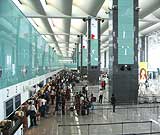 Non resident Indians, that breed once considered a privileged lot, are said to be returning to India in droves; some out of new-found respect for India, others to seize new opportunities and many others victims of recession in the West and the Gulf.
Non resident Indians, that breed once considered a privileged lot, are said to be returning to India in droves; some out of new-found respect for India, others to seize new opportunities and many others victims of recession in the West and the Gulf.
They are confronted by an India that is shockingly different. Yes, the creaking infrastructure, population explosion, pollution and traffic jams are still there; but scratch the surface, and India is a goldmine, a land of opportunities, provided you are ready to grin and bear the minor hiccups.
Bengaluru Airport... times have changed
Two decades ago, landing a job in the Gulf was an average Indian’s biggest wish, next only to getting a green card in the US. Many were ready to pawn their wife’s gold and sell their ancestral property to go and shake the money trees of the Gulf. While ordinary Indians slogged in unliveable cities, commuting like cattle and broke at the end of each month, their Gulf cousins sent piles of notes, gold and electronic goods to their families every month. The situation has reversed now. Well almost. Last week, I had to make a quick dash to India and came back confused and flabbergasted.
My first stop was the city of Bangalore, now renamed
Bengaluru. Formerly known as the pensioner’s paradise, Bangalore is now the favourite pad of geeks, but amid the pockets of IT campuses and gleaming glass buildings, Bangalore is still a laidback and green city, blessed with a salubrious climate, but cursed by choking traffic, thanks to unplanned growth.
The new Bengaluru International Airport, located 35 km from the city
centre, is way too small for a city that is growing on all sides. The lone highway connecting the airport to the city is jammed with traffic, and it takes nearly two hours to reach the city. The Metro, now in finals stages of construction, and several half-completed flyovers, add to the chaos. As you drive through, the only consolation is the vast stretches of greenery and open land on either side.
To a struggling NRI from Dubai like me, modern India has plenty of shocks in store. First, the three-star hotel in
Bengaluru, located 15 km from the city centre, cost me Rs. 7,000
(AED 565) a night for what they called a suite, which was well below the standard of a two-star Dubai hotel.
There was a time when NRIs felt ecstatic every time they paid in Indian rupees and mentally calculated the sum in Dirhams with great glee. Now, when they convert rupees into
dirhams, it seems like daylight robbery. Eating out, clothing and everything else seems to be overpriced, but the locals are not complaining, generally speaking.
From Bangalore to Bombay, it is just about 90 minutes’ flying time. There are numerous budget and luxury airlines operating in the Indian skies. But try booking a seat, and it is as frustrating as seeking admission in an Indian college. And, by some miracle if you grab a seat, the fares are astronomical enough to make you lose your sanity. A sum of
Rs. 13,400 (AED 1,085) for a one-way fare to Bombay was a rip-off, but our nouveau riche Indian cousins thought nothing of it as they flashed wads of notes at the airport counter.
You land in Mumbai, and a renovated airport comes like a breath of fresh air, a welcome change from the old dilapidated airports. The disorderly traffic and pollution hanging thick in the air almost force the inflight breakfast out of my system. But thankfully, there are air conditioned cabs to shield you from Mumbai’s smells and smoke.
Swanky cars mingle with rickety auto-rickshaws and smoke-belching trucks along the highway that is lined with ground-plus-one slums. But there are signs of prosperity everywhere in the form of elegant glass building and rising towers.
The next day, I make a trip to Navi Mumbai, the satellite city whose airport has been in the offing for over 10 years (and was finally given clearance on November 22) and a sea-link bridge that is still hanging fire. It takes more than 90 minutes to reach my destination on Mumbai-Pune Expressway by car, after traversing through Dharavi slums made famous by the movie Slumdog Millionaire. Asia’s largest slum is still untouched and filthy, despite a plan to convert it into a modern residential township.
In shops, restaurants and malls, Indians are all on a spending spree. This is the new India where inflation is taken for granted, and a new generation has arisen, that thinks less of tomorrow and more of today.
It was time to return to my adopted Gulf city. But finally I found the silver lining. No country can beat India in prices of books and medicines. For one-tenth of the price in most parts of the world you can buy the best of medicines; and for one-third of international price you can buy the best of books. At my age, give me low-priced books and world’s cheapest medicines, and I am ready to make it my home, forever.
—Courtesy khaleejtimes.com
|